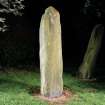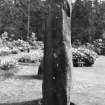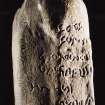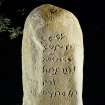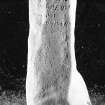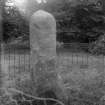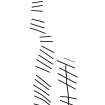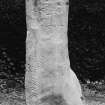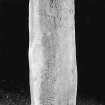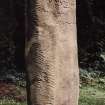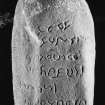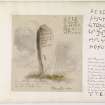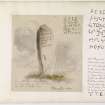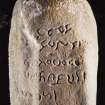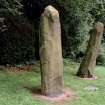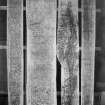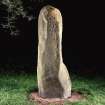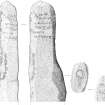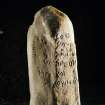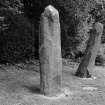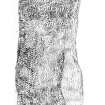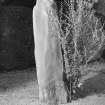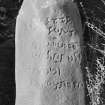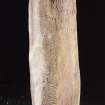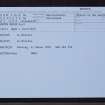Following the launch of trove.scot in February 2025 we are now planning the retiral of some of our webservices. Canmore will be switched off on 24th June 2025. Information about the closure can be found on the HES website: Retiral of HES web services | Historic Environment Scotland
Newton House, The Newton Stone
Ogham Inscribed Stone (Early Medieval), Pictish Symbol Stone (Early Medieval)
Site Name Newton House, The Newton Stone
Classification Ogham Inscribed Stone (Early Medieval), Pictish Symbol Stone (Early Medieval)
Alternative Name(s) Newton In The Garioch
Canmore ID 18086
Site Number NJ62NE 12.02
NGR NJ 6623 2972
Datum OSGB36 - NGR
Permalink http://canmore.org.uk/site/18086
- Council Aberdeenshire
- Parish Culsalmond
- Former Region Grampian
- Former District Gordon
- Former County Aberdeenshire
Newton House 2 (The Newton Stone), Culsalmond, Aberdeenshire, inscribed Pictish symbol stone
Measurements: H 2.03m (above ground level), W 0.50m, D 0.26m
Stone type: blue gneiss
Place of discovery: NJ 6623 2972
Present location: still in situ in the grounds of Newton House.
Evidence for discovery: found around 1803 and first recorded by John Stuart in 1835 in a wood about a mile from Newton House, and subsequently moved to the grounds of the house (discussed in Forsyth 1996, 420-2).
Present condition: some weathering.
Description
An irregularly shaped natural pillar, its two inscriptions in ogham and half uncials have been long recognised, but RCAHMS fieldwork in the later 1990s revealed that there are also two curvilinear incised designs. The ogham inscription runs vertically down the stone and curves round to ascend again, and it includes the personal names Idarnon and Vorenn. The half uncial letters run horizontally in six rows across the top of the stone, beginning at the same level as the ogham, and it is difficult to read but appears to include personal names. The two inscriptions are thought to be contemporary but not identical (Forsyth 1996, 425, 439). At approximately the level of the curve in the ogham inscription but on the other flank of the stone, there is a roughly executed mirror symbol and a spiral motif.
Date: sixth or seventh century.
References: Stuart 1856, 1, pl 1; Okasha 1985, 54-6; Forsyth 1996, 420-42; RCAHMS 2007, 118, 125; Fraser 2008, no 38.2.
Desk-based information compiled by A Ritchie 2017
Field Visit (13 March 1969)
Stones as described; no further information regarding original find-spots, or graves.
Visited by OS (NKB) 13 March 1969.
Reference
The ogam-inscribed stone (The 'Newton Stone') is of blue gneiss, 2.03m x 0.5m and bears at the top six horizontal lines of characters and an ogam-inscription down the left angle and lower front of the stone. The Pictish symbol stone is of blue-grey greiss. It measures 2.05 x 0.6 x 0.41m and is roughly pillar-shaped, incised with the double-disc and serpent crossed by a z-rod symbol.
(Unattributed) information on OS Archaeology Record Card.



































